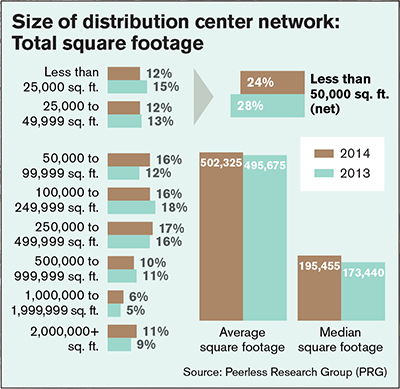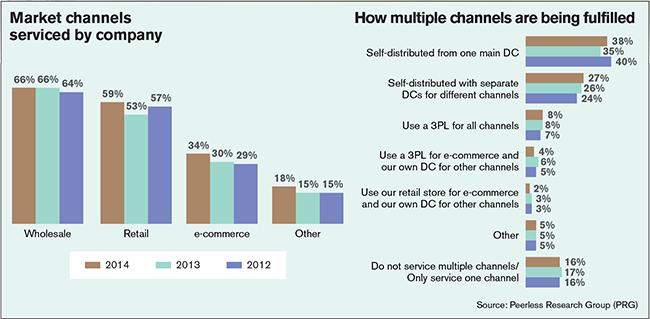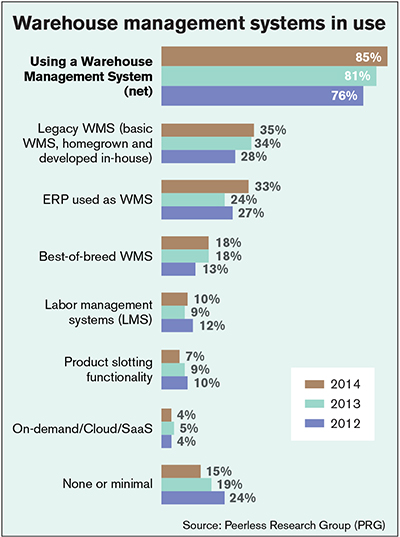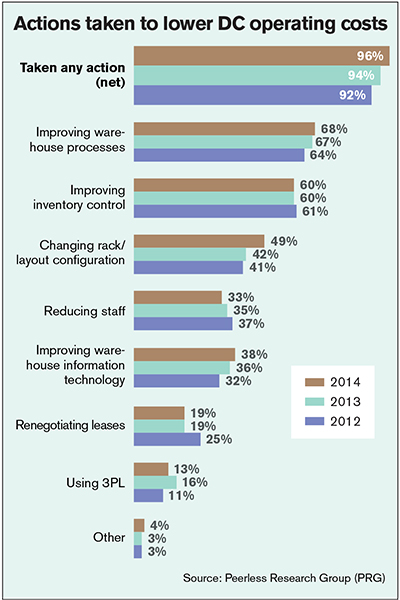2014 Warehouse/DC Operations Survey: Industry gets crafty
According to our annual survey, cost efficiency is still king. However, respondents tell us that the multi-channel fulfillment challenge is pushing them to make more economical moves focused on process improvement and layout changes—steps our analysts say are very encouraging.
Latest Logistics News
LM Podcast Series: Assessing the freight transportation and logistics markets with Tom Nightingale, AFS Logistics Investor expectations continue to influence supply chain decision-making Under-21 driver pilot program a bust with fleets as FMCSA seeks changes Diesel back over $4 a gallon; Mideast tensions, other worries cited Four U.S. railroads file challenges against FRA’s two-person crew mandate, says report More NewsThe results of our annual Warehouse and Distribution Center Operations Survey are in, and, once again, cost efficiency is king. But this isn’t the type of pure cost control seen in recent years when budgets were tight or in decline and DCs could rarely bring in new systems.
Instead, this year’s survey shows a willingness to invest to meet the pressures of multi-channel fulfillment in a more cost efficient way. In short, the survey reveals respondents are more willing to spend a little to gain a lot.
And according to our analysts, these professionals now understand that trying to tackle multi-channel complexities and a stronger economy with the same old systems and processes will not get them to the level of cost effectiveness their organizations need.
On top of these economically motivated innovations, we also see clear evidence of growth in this year’s survey, says Don Derewecki, senior consultant with St. Onge Co., a supply chain consulting firm and our partner for the annual research project. Among this year’s findings are:
The average number of employees is up slightly, from 236 in 2013, to 249 in 2014.
Square footage within respondent DC networks is up, by 6.4% on average.
- Capital expenditure among respondents averaged just more than $1.3 million in 2014, up 24% from last year’s average of slightly less than $1.1 million.
“When you look at average square footage being up by 6.4%, and by 12.7% on the median, those are pretty healthy increases,” says Derewecki. “People don’t go out and get more space when they are cutting back.”
When you combine these survey findings with reports of spot shortages for DC labor in some areas, as well as the drying up of excess capacity for warehouse space, it’s clear that the warehouse and logistics market is expanding. “There is more activity going on, generally,” says Derewecki.

The surge in activity brings with it a slew of different challenges than what was normal for a DC a decade ago when it was common to get full pallets in and full pallets out, says Norm Saenz, managing director for St. Onge. In our 2014 survey, only 16% of respondents report receiving only full pallets of a single SKU.
There’s also more complexity on the outbound side of operations, with a need to pick individual e-commerce orders efficiently, as well as fill leaner orders to retailers or other businesses that, during the recession, got used to ordering in smaller, more frequent quantities. “Many companies had systems and processes that were set up for the full pallets and bigger shipment profiles of the past, but you have a lot more complexity now,” says Saenz.
But perhaps the most encouraging trend from the 2014 survey is that respondents are finding multiple ways of dealing with pressures such as more e-commerce orders and growing demand for value-added services.
From more use of IT such as warehouse management system (WMS) or transportation management system (TMS) solutions, to changes to layouts and racks, warehouse and DC operations leaders are pursuing various ways of coping with complexity. There’s expenditure involved, but the spending is seen as way of being more efficient given the pressure of today’s smaller orders and intensive materials handling requirements.
“People responsible for DCs are being very crafty this year,” says Saenz. “There seems to be an uptick in focus, in creativity, and in diligence—really just smart management around process changes, layout changes, looking at transportation routings, and making better use of technology to help control costs. And those are all positive signs.”

Fundamental challenges
Most participating companies in this year’s survey came from manufacturing (40%), followed by distributors (31%), third-party logistics providers (11%), and retailers (8%). Leading product sectors included food and grocery, general merchandize, and health care and pharmaceuticals.
As noted, only 16% of respondents deal only with full pallets of a single SKU on the inbound side, and 9% on the outbound side. On the inbound side, 30% handle mixed case pallets and loose cases, followed by 28% who handle full pallet of a single SKU, mixed case pallets, and loose cases. On the outbound side, the most common scenario (33%) is mixed-case pallets and loose cases, followed by 26% who handle full pallets of a single SKU, mixed case pallets, and loose cases.
In terms of multi-channel requirements, 34% of respondents service an e-commerce channel, up from 30% last year. Only 16% of respondents say they service only one channel. When it comes to how multiple channels are fulfilled, the leading strategy is self-distributed from one main DC, practiced by 38%, followed by 27% who self-distribute from separate DCs for different channels.
While the e-commerce growth is not high, notes Derewecki, it’s on the increase, and in effect, 84% of respondents service multiple channels to some degree.
As noted, the 2014 survey saw an increase in the number of employees per respondent company, while square footage was also on the rise. Total square footage in the network averaged 502,325, up from 495,675. The median figure for total square footage also climbed, from 173,440 last year to 195,455 this year. When asked if they planned to expand in the next 12 months, 74% said “yes”—up from 72% last year.
The demand on DCs for value-added services is also on the rise. This year 87% said that they performed value-added services including special labeling (56%), kitting (29%), and promotional packs (29%). Overall, value-added services have increased steadily the last two years, from 82% performing them in 2012, to 87% performing them today.
All these factors—more e-commerce, more handling of small orders, expanding operations and labor forces—add up to greater complexity. “Generally, operations are much more complicated than they were even five or 10 years ago,” says Derewecki. “Any little thing that goes wrong can’t be hidden—it comes to the surface quickly. This complexity is also leading to the use of more mechanization and technology to be able to comply with all of these requirements.”

Actions and investments
This year’s respondents have been proactive. When asked if they had taken action in the past 12 months to lower DC operating costs, 96% said they took some type of action, up from 94% in 2013, and 92% in 2012. Leading areas of action included improving warehouse processes (68%), improving inventory control (60%), and changing rack/layout configuration (49%).
Changing rack and layout configuration saw one of the bigger increases, rising by 7%. In keeping with the generally stronger economy, the number of respondents saying that they have reduced staff as a means of controlling costs has declined the last two years, while “improving warehouse IT” has risen slightly the last two years.
To both Derewecki and Saenz, the willingness to take action is a major positive in this year’s survey. “Those indicators are all good news,” says Saenz, “We’re seeing more people taking actions, focusing in on process improvements, or on layout changes. It’s all encouraging.”
Some actions need not entail huge technology investments. For instance, because of the rise in smaller orders and e-commerce, more companies have been changing rack configurations. This is typically done to create more pick slots, says Saenz.
More respondents are also shifting toward the use of mechanized materials handling systems for both receiving and picking. Mechanized or conveyor-based receiving among respondents reached 15%, an increase of 3% over last year, while mechanized picking rose to 16%, up 2% from 2013 and double the 8% use rate in 2012.
Meanwhile, paper-based picking has declined from 66% in 2012 to 60% in 2014, and voice picking is on the rise, with voice assisted picking with scan verification up by 2% versus 2013.
Companies have also steadily moved to adopt WMS. While WMS has been around for decades, 85% of respondents now use a WMS of some type, up from 76% two years ago. Use of enterprise resource planning (ERP) systems for WMS rose from 24% in 2013 to 33% in 2014, while use of labor management systems software also rose slightly.
“That’s a very good penetration rate for WMS, considering that there are many smaller sized respondent companies in the survey, and that just two years ago, it stood at 76%,” notes Derewecki.
With multi-channel pressures likely to increase, says Saenz, it will be interesting to see if future surveys start to reflect more use of “best of breed” WMS. In 2014, use of best of breed held steady at 18%, but as Saenz notes, with complexity on the rise, companies will need solutions capable of batch picking in which multiple one line orders can be managed, which may push more companies toward advanced solutions.
“I’m surprised we haven’t seen increasing use of best of breed, but I think it will start to happen soon,” says Saenz.
Respondents were also active with initiatives to reduce transportation costs, with 88% taking action of some type. Among the most common methods of reducing transportation costs is to renegotiate rates, although a slightly smaller percentage of respondents reported using that tactic in 2014 compared to 2013.
One tactic that did see an uptick (6%) was using TMS to optimize routes, an action taken by 22% of respondents in 2014. “That shows some real effort in studying the logistics costs and routings to find new ways of getting orders to the customer in the most efficient manner,” says Saenz.
In short, there isn’t one silver bullet for improvement, with respondents tapping everything from increased use of WMS to reconfiguring racks. As Derewecki sums up: “The majority of the people are taking multiple actions to improve their operations and lower costs.”
Also encouraging, agree Derewecki and Saenz, is the fact that 90% of respondents are now using some type of productivity metric within the warehouse, such as tracking units per hour, lines per hour, or attainment rate on a labor standard. That fits with the smart management mentality needed today, says Saenz. “That tells me companies are looking at metrics as a way to help manage the continuing change toward more complex distribution operations,” he says.

Cause for concern
The survey also tracks green supply chain and supply chain disruption issues. In terms of sustainable or green
initiatives such as recycling, energy efficient lighting, or use of fans to improve air circulation, interest remains steady. Overall for 2014, 94% of respondents undertook at least one environmental initiative, up a mere 1% from 2013.
The percentage of respondents who experienced a catastrophic event in 2014 actually declined slightly from 2013, from 17% to 13%. However, the question elicited many individual comments on actions taken, including dual sourcing, more emphasis on domestic suppliers, installation of power protection solutions, and updating or improvement of disaster recovery plans.
“The fact that 13% of respondents experienced a disruption is significant,” says Derewecki. “Companies know that they have to be prepared, because they know that, sooner or later, an event of some type is going to roll around to hit them.”
However, the main day-to-day cause for concern comes back to the pressures of today’s smaller, more frequent orders and intensive item handling in multi-channel environments. At the same time, the healthier U.S. economy is seeing more respondents increase employee head count as well as the amount of warehouse space. In effect, today there’s more fulfillment complexity, and at a higher volume than recent years.
To top things off, the labor market is tighter, with 43% of respondents naming workforce retention as a major operational issue, tying with “insufficient space for inventory and/or operations” as the top area of concern.
Just as multi-channel complexity is driving changes in DCs, so is the tighter labor market, says Derewecki. Both trends constitute a cost drain if DCs cannot adapt to them in efficient ways, he adds, such as through better technology that makes it easier to get new employees up to speed.
“Companies are realizing that they need to do one of two things, and possibly both, to deal with the tighter labor pool,” Derewecki adds. “For one, they may need to raise pay rates to hold on to people; and two, they are going to have to improve their processes and technologies to gain more productivity and payoff from that investment in labor.”
By the numbers
Our annual Warehouse/DC Operations Survey gauges trends in warehouse and DC operations, including size and scope of distribution activities, labor factors, expenditures, use of information technology (IT), as well as green initiatives and experience with supply chain disruptions. In September, the questionnaire was sent via e-mail to Modern Materials Handling and sister publication Logistics Management magazine subscribers, garnering more than 350 qualified responses from managers and executives involved in DC operations.

Article Topics
Latest in Logistics
LM Podcast Series: Assessing the freight transportation and logistics markets with Tom Nightingale, AFS Logistics Investor expectations continue to influence supply chain decision-making The Next Big Steps in Supply Chain Digitalization Under-21 driver pilot program a bust with fleets as FMCSA seeks changes Diesel back over $4 a gallon; Mideast tensions, other worries cited Four U.S. railroads file challenges against FRA’s two-person crew mandate, says report XPO opens up three new services acquired through auction of Yellow’s properties and assets More LogisticsAbout the Author
Subscribe to Logistics Management Magazine

Find out what the world's most innovative companies are doing to improve productivity in their plants and distribution centers.
Start your FREE subscription today.
April 2023 Logistics Management

Latest Resources














